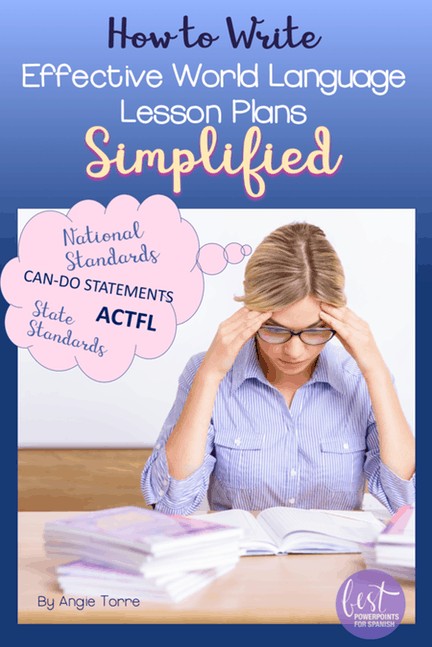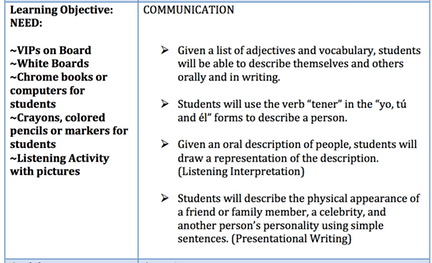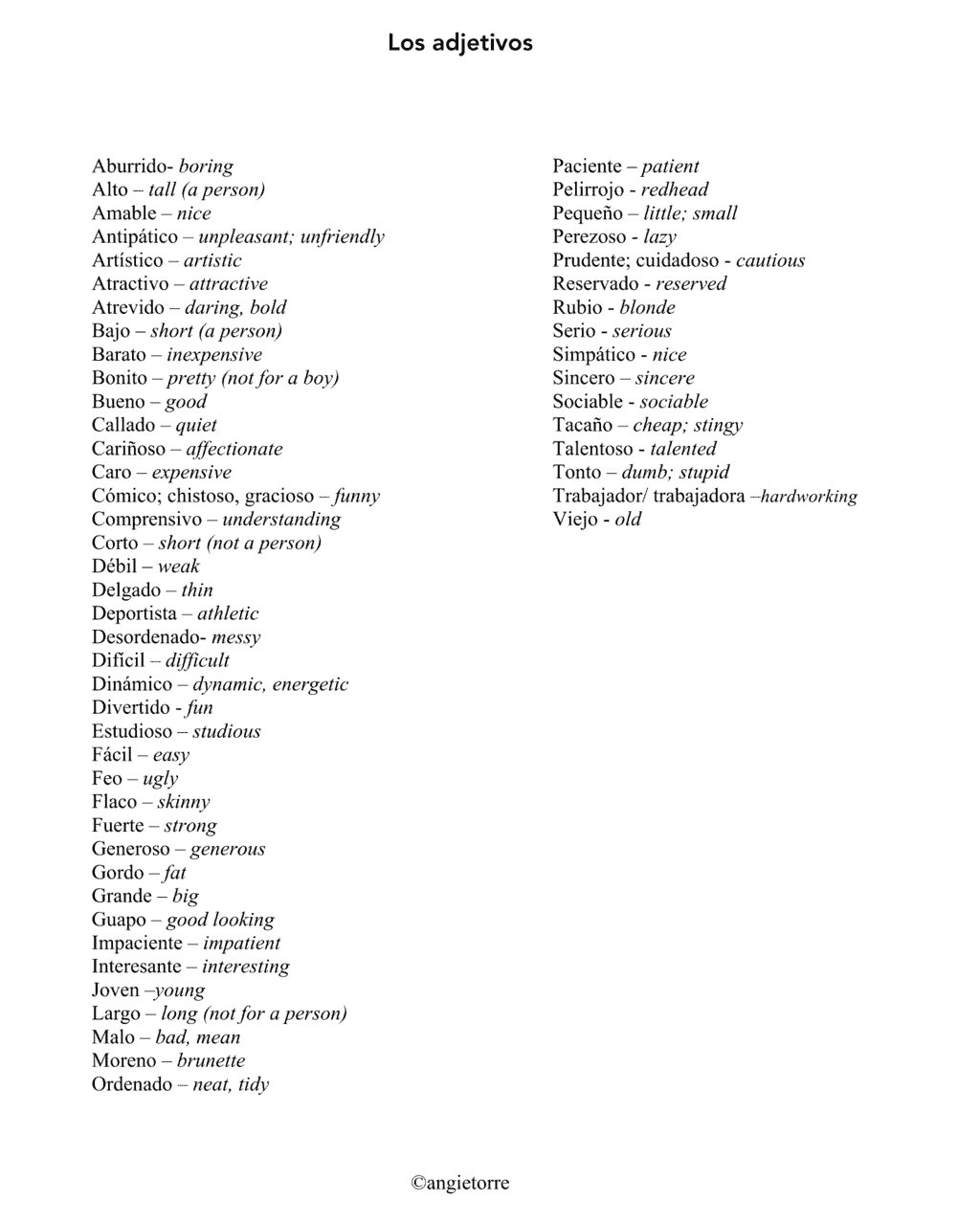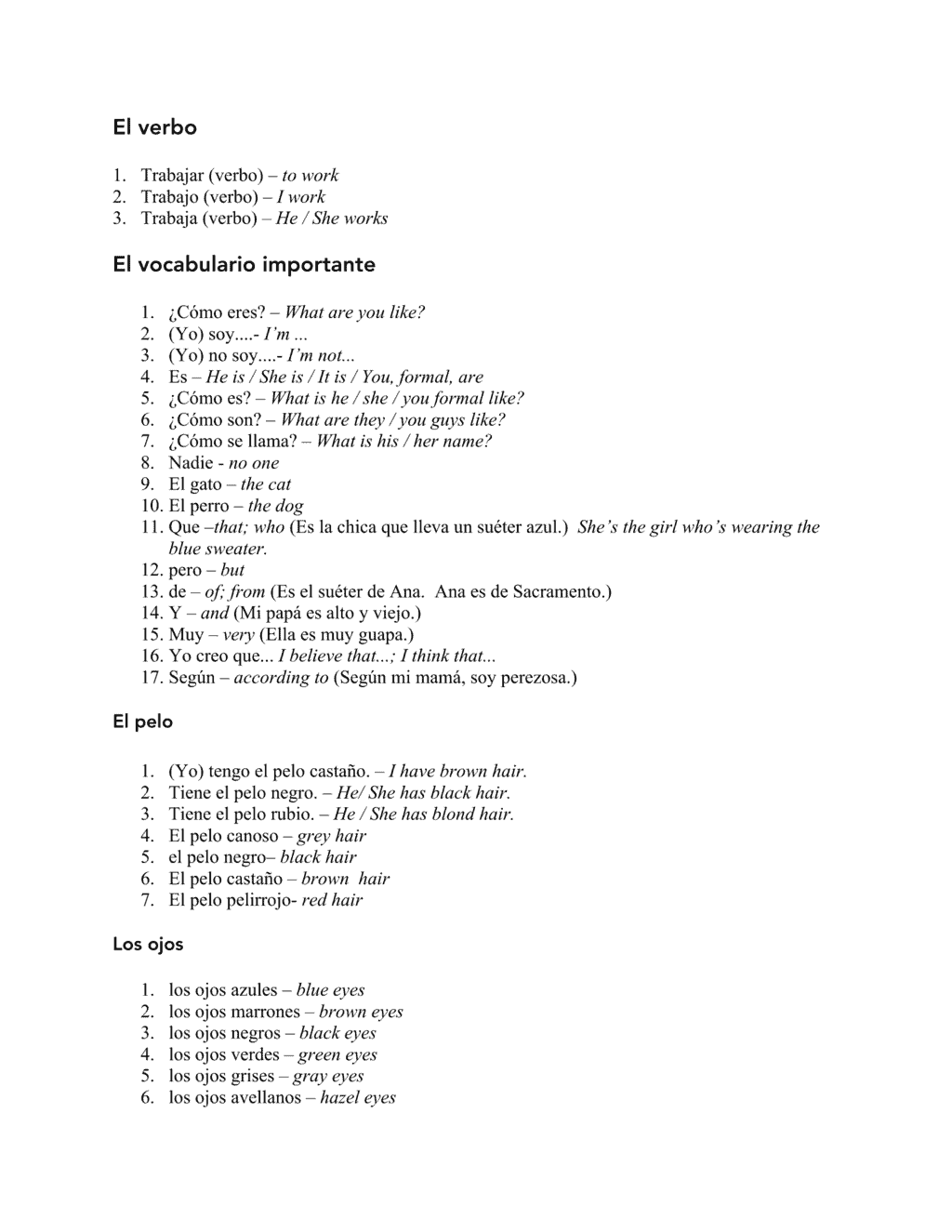How to Write Effective World Lesson Plans, Simplified
Would you like to know how to write effective lesson plans? Honestly, writing World Language lesson plans can be overwhelming at times. At the end of the day when my brain is most fried, I not only have to be creative but I have to make sure to include all the important elements. So, I’m going to SIMPLIFY the process for you.
How to Write Effective Lesson Plans
What are the Basic Parts of a Lesson Plan?
A lesson plan must contain certain essential components in order to engage students and lead them to proficiency.

The first component, and the most important, is the learning objective.
Before determining my learning goals, I must first look at the standards. Um…which ones? The National Standards, the State Content Standards, the ACTFL Can-Do Statments, The ACTFL Proficiency Guidelines ?
Agh! I’m so overwhelmed!
Using “Can-Do Statements” is helpful in finding objectives and you should definitely know your State Content Standards. However, consider my simplified version: Embed culture (with comparisons of students’ own and that of Spanish-speaking countries) and knowledge of other subjects matters; assign tasks requiring the use of the target language outside the classroom; and provide opportunities for students to read, write, speak and listen to authentic resources, not necessarily in every lesson. Now, let’s begin planning our daily lesson.
How to write effective lesson plans: Know what your learning goal is. Before creating a lesson plan I always ask myself, “What do I want my students to be able to do at the end of this lesson?
If I don’t know where I’m going, I’ll never get there.
First, what function do I want them to perform? This function should be part of a THEME or topic. Let’s pick “celebrities,” as an example, and compare some American stars to a few Spanish-speaking ones (Embed culture).
For example, students will: Talk and write about famous Spanish speakers; write a comparison of American singers and Spanish singers; describe themselves and others orally and in writing; and write an essay describing the physical appearance and personality of friends, family members and celebrities.
Below are learning objectives taken from my lesson on describing people. (On the left is a list of items needed for this lesson.)

The goal statement must be specific, focusing on action verbs: Students will write about, listen to, identify, talk about, present orally…” The more specific it is, the more likely the students will reach the goal.
Second, what knowledge (vocabulary, grammar, cultural facts) do they need to know in order to achieve these goals? At this point, I make a list of vocabulary and related expressions that will help my students express themselves on this topic. Otherwise, my students will speak English or use Google Translate because I have not supplied them with the sufficient vocabulary to accomplish the tasks I’ve given them.
Vocabulary List
 Related Expressions
Related Expressions Necessary Grammar
Necessary Grammar


Here is the model I used for the biography students wrote using the adjectives. (Of course, it will have to be modified now that we have a new president.)



As I am brainstorming, I make sure to include the resources I will need in order to keep my class functioning in the target language – the subject of a future blog in this series.
I articulate the learning objectives with the students at the beginning of the class, explaining what we are going to do and what THEY will do at the end of the lesson to demonstrate proficiency. That’s called tension which will be discussed in my next blog as we continue to talk about how to write effective lesson plans. Stay tuned!
I hope this blog gave you some ideas for how to write effective lesson plans. I look forward to hearing from anyone who would like to comment.
I hope your school year is progressing nicely.
Angie
TODAY’S FREEBIES:
Sample Lesson Plan on Physical Descriptions
Spanish Adjectives Listening and Writing Assessments
Click here to see the Spanish Adjectives PowerPoint and Interactive Notebook Activities
If you really dread the task of writing your own lesson plans, don’t do it! Go home early! Why reinvent the wheel when I have spent thirty years writing and polishing lesson plans?
Click here to see my Spanish One Lesson Plans and Curriculum for an Entire Year. You will not need a textbook with these lessons but you can use them in conjunction with your textbook if you like.
Click here to see my AP Spanish Lesson Plans and Curriculum for an Entire Year
Click here to see a short video about my lesson plans: Todos preparados Lesson Plans
For more information about how to craft a good lesson plan, click here: Teaching World Languages: A Practical Guide
ONE MORE FREEBIE: This is my first PowerPoint game and I would like your feedback.
Would you like to have access to more PowerPoint games like this one? They are super fun, great practice during the recognition phase for comprehensible input and they are self-correcting. You don’t have to correct anything! Take a look: Numbers PowerPoint Game
If you would like more freebies and teaching tips, make sure to sign up for my blog! Scroll to the bottom to sign up.
This is the first in a series of eight blog posts on how to write an effective world language lesson plan. Here are the following seven posts:
Effective World Language Lesson Plans, Part Two (How to Add Tension)
Effective World Language Lesson Plans, Part Three (The Hook)
Effective World Language Lesson Plans, Part Four (How Explain, model, demonstrate)
Effective World Language Lesson Plans, Part Five (How to Check for Understanding)
Effective World Language Lesson Plans, Part Six (How to Add the Best Comprehensible Input)
How to Choose the Best Practice Activities for World Language
To receive freebies and notifications of new products, click on the following link to follow my store: ANGIE TORRE
SaveSave



This was everything!!!! Thank you!!!! It’s important to see backwards design in planning and teaching a foreign language and with comprehensible input. I thought I was giving too much information at first. But you listed nearly everything for the student to NOT use additional resources (ie Google). ? I’ve got some planningto do. Thanks again!
Glad you enjoyed the post! Thanks for your comment.
This was so helpful!! In school, I was told about backwards design but was never taught how to do it. No one’s ever very helpful in explaining it for foreign language, just their own content, so I’m always floundering. I’m so glad I read this! It makes everything so much more clear!
I’m so glad you found it helpful!